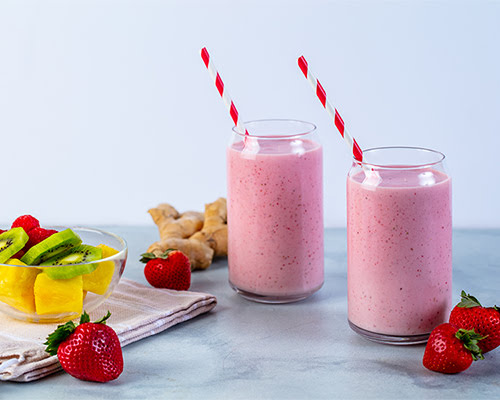
Categories: jams, jellies & spreads / salads & fruits / Summer
Whether it’s extra berries from a fruitful picking adventure or perhaps a basket of ripe goodness from your grandmother’s pear tree, you’ve got more fresh fruit than you can eat. Canning is the perfect way to store it. With this helpful guide, we will cover the basic steps to canning fresh fruits, so you can enjoy them regardless of the season and have them on-hand to make baking as easy as pie.
Pick Out Your Fruit
Pick out fruit that is fresh, firm and not overly or underly ripe. Remember, the fresher the fruit the better it will taste in your recipe. Obviously, the freshest selection will come from growing your own. If you are missing a green thumb, then look for a local farm for fresh fruit grown in your area. Your local farmers market will likely have an impressive assortment of fresh options as well. After you’ve picked out your perfect fruit, you’ll need to gather your canning supplies.
Gather Your Supplies
Before getting started, you’ll need the right tools for the job. Here are the canning-specific supplies you’ll want to acquire:
- Glass jars
- New rings and lids
- A canning pot with a round jar rack
- A canning funnel
- A lid lifter
- A jar lifter
Look for these items at your local baking supply shop or purchase them online. In addition to canning-specific supplies, you’ll need a few general supplies. Here is a basic list, but remember to refer to your recipe for the specific items you may need:
- Cutting board
- Paring knife
- Colander
- Chopstick or table knife
- Shallow glass (or ceramic) bowl
- Medium size measuring cup
- Slotted spoon
- Ladle
- Paper towels
Once you have your supplies in order, it’s time begin the canning process.
Follow These Steps For Canning Success
Step 1: Prep Your Jars And Lids
Begin by cleaning your jars thoroughly. Then, fill your canning pot with water and set it to boil. Carefully submerge your round jar rack until it settles to the bottom of your pot. Set your jars onto the submerged rack. Place your lids into a separate bowl and add a cup or two of simmering water. This will help soften the lid’s sealing compound. Once your jars have boiled for ten minutes, remove each jar carefully and place them on a paper towel.
Step 2: Fill Your Jars With Freshly Preserved Fruit
Whether you use your great grandmother’s prized recipe or one that has been recently published, the process of filling jars hasn’t changed much over the years. First, you’ll want to insert your canning funnel into one of your sterilized jars. Use a slotted spoon to transfer your fruit into the funnel. Be sure to leave a ¾” gap or “headspace” between your fruit and the top of the jar. Then, begin to ladle the liquid from your cooked fruit into your jar until it reaches ½’’ of headspace. Once your jar is filled, whisk a chopstick or table knife around the filling to remove excess air. Wipe each jar with a paper towel. Be sure to remove any filling residue from the mouth of the jar.
Step 3: Seal Your Success
Using your jar lifter, remove a sealer lid from the bowl of warm water. Place your lid evenly so that its sealing compound lines up with the jar’s rim. Gently tighten your lid-ring cover over the top. Remember not to over-tighten, some air needs to escape during the boiling process to create a vacuum seal. After you have secured the lids on all of your jars, place them carefully into your canning pot so that no jars are touching each other or the edges of your pot. Add water to the pot until there is ½” covering your jar lids. Now, set your stove timer to the amount of time directed by your recipe. Once your water starts to boil, start your timer.
Step 4: Carefully Remove Your Freshly Sealed Jars
Once your jars have processed for the amount of time directed by your recipe, carefully remove them with your jar lifter, making sure to keep them level. Place each jar on a paper towel that is out of the way. Once cooled, remove all of the jar’s outer rings and lift lightly on the flat lid to test if it is sealed properly. If sealed properly, you will not be able to remove the lid without force. You can also test the jar’s vacuum seal by pressing down on the top of the lid with your finger. If there is no give in the lid, your jar is sealed properly. If the lid pops down and back up, the seal has failed.
Step 5: Store Your Freshly Canned Fruit
Now you can store your freshly canned fruit to be enjoyed in everything from ice cream to pie fillings. All jars that are successfully sealed can now be stored in a cool, dark place to be enjoyed for the length of time prescribed by your recipe. Jars that failed to seal properly can be stored in your fridge and may be enjoyed for up to 3-4 months. When storing your jars, avoid stacking them any higher than two tiers. This will keep excess pressure off your lids and increase the chances that your vacuum seal will not being broken before you’re ready to enjoy your preserves. You can also add a layer of cardboard between your rows to avoid direct contact with the bottom of the jars and your lids. This step is a manufacturer-recommended measure to keep your seals nice and tight. Your cupboard full of fruit preserves will bring joy for months to come.
Try One Of Our Tried-And-True Recipes
When it comes to canning fruit, you’ll want to make sure that you are using a recipe that has a history of success. This will ensure that the fruit you prepare not only tastes amazing but will stay fresh for as long as possible. Here are a couple of C&H® recipes we recommend:



